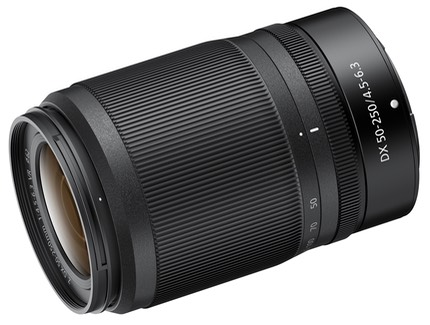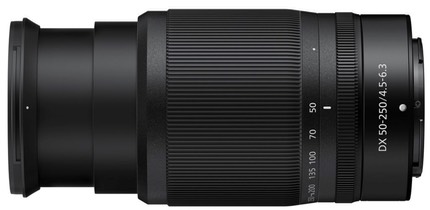= = = = = = = = = = = = = = = =
Nikon Z Camera Owners: Up-to-date information and new articles by Thom Hogan are available at zsystemuser.com, which continues to follow all Nikon mirrorless camera news and information in 2026 and the future.
= = = = = = = = = = = = = = = =

What is It?
The 50-250mm f/4.5-6.3 VR DX was the third surprise when it was announced with the Z50 camera. The Nikon Z Lens Road Map didn't mention any DX lenses at the time, probably to not give away the fact that Nikon would be using the Z mount for crop sensor mirrorless until the first DX camera was announced.
At just 14.3 ounces (405g) and less than 4.5" long (110mm) in its collapsed state, the 50-250mm is a compact telephoto zoom lens. It's about the same size as the 20mm f/1.8 S, and lighter! Typically a 250mm lens would be 250mm from the front element to the sensor. Retracted, the 50-250mm is less than half that. Even fully extended, it still comes a couple of dozen millimeters short of expectation.
At first glance, it may seem that costs were cut, corners were taken. The lens is all-plastic, including the lens mount (though a very hardened and wear-resistant polycarbonate). The mount does not feature a rubber weather gasket, nor does it have an overhanging drip protector ring. The 16 elements in 12 group design seems a little on the low side for a serious telephoto-range zoom, the f/6.3 aperture on the telephoto side is a bit disappointing, and the 7-blade aperture diaphragm also appears to be another penny pinch. One final cost cut: no lens hood is supplied with the 50-250mm f/4.5-6.3.
Yet, closer examination shows one ED element, plus VR is built in (5 stops CIPA rating). As you'll see in the Performance section, below, this lens somehow manages to rise above its US$300 implied cost when bundled with a Z50 camera.

As with a lot of Nikon's recent kit-type lenses, especially for the smaller sensor cameras, the 50-250mm is a collapsing lens for travel. You must extend it by rotating the zoom ring to at least the 50mm position in order to take photos (the camera reminds you of this if you don't). This pushes the lens front out almost two inches (technically 40mm), and the lens is at its longest at 250mm where the front extends to 8" from the camera mount (200mm). In other words, the lens almost doubles in length from collapsed to full extension. There's also a very slight rotation (10-15°) as the lens zooms.
The variable aperture impacts work out like this:
- 50mm — f/4.5
- 85mm — f/5
- 135mm — f/5.3
- 180mm — f/5.6
- 200mm — f/6
- 250mm — f/6.3
The zoom ring is marked at 50mm, 70mm, 100mm, 135mm, 200mm, and 250mm.
Nikon's optional hood for the lens is the HB-90A, which bayonets onto the lens normally or reversed. A less expensive third party version of the lens hood can be found here. The filter ring is 62mm, which does not match the other lens in the two-lens kit (16-50mm).
Note that if you mount this lens on the full frame Nikon Z cameras, they automatically detect that this is a DX lens and switch to the DX crop, which can't be overridden (as it can on the DSLRs when you mount a DX lens).
The 50-250mm f/4.5-6.3 is made in Thailand and sells for US$349 if bought separately, or has an implied cost of US$300 if bundled with a Z50 as I write this.
Source of the reviewed lens: bundled with purchased camera
How's it Handle?
If I have a complaint, it would be that the zoom ring rotation is less than 90° and not particularly smooth. This makes it difficult to dial in a very specific framing accurately, repeatedly, or to zoom smoothly when shooting video. You'll also definitely hear the lens on the mics while zooming during video.
I've had this lens on and off my Z50 quite a bit already. The plastic mount shows no wear and is holding up just fine. Other Nikkors that have used plastic at the mount have not proven to be a problem in the past, either.
I don't like the lack of a VR switch. As I've noted before, the Z cameras don't let us assign VR to a button, so you end up having to menu dive to change VR status.
Overall, there's not much to complain about in handling because there's, well, not much to handle. As kit lenses go, this one just doesn't get in your way once it's ready to shoot.
How's it Perform?
Focus: Nikon makes the claim of "suppress[ing] focus breathing." Yes, for the most part this is true. Some of that is in-camera lens correction, though.
Focus speed is quite good. There's no real slide-to-focus-position effect as you sometimes see with the less expensive optics.
Sharpness: Surprisingly, at pretty much every focal length this lens is (mostly) best optically wide open. There's no real need to stop down to get better results, though you can pull the corners in a bit at 50mm by stopping down. Center sharpness isn't bad at all, much better than you'd expect for the money, and what I'd tend to call very good. The lens is sharpest at about 70mm, but 50mm doesn't lag by much. Centrally, 250mm is the worst performer, and probably falls down into what I'd call good.
The corners aren't as well defined as the center. Again, 70mm seems to be the best focal length, but 135mm actually is probably second best for corner performance. The two extreme focal lengths are the laggards in the corners, with performance being what I'd call fair.
All that said, for its price, the 50-250mm is probably better than most people would expect. It's not going to knock your socks off with acuity, but it's far from being a blurry mess, either. I would tend to avoid f/11 through f/22 with the lens due to diffraction impacts added onto the optical constraints.
Chromatic Aberration: Sort of the reverse of what I would expect: there's visible pixel-wide lateral CA at the shorter half of the focal range, but that drops in half in the longer focal lengths of the lens. In no case is it objectionable, and it's easily correctable. I didn't see much longitudinal CA, but I wouldn't expect to with a lens this slow in aperture.
Linear Distortion: I had to scratch my head on this one. The Nikon-supplied corrections are pretty spot on, falling below levels I'd try to give a number to. That's unusual. Typically linear distortion correction tends to leave some small residual distortion behind. The fact that the corrections are so good indicates that this lens didn't start with much distortion to correct.
Vignetting: Most of you will use the in-camera (or raw supplied) lens corrections, and here the news is basically good. Nikon corrects the vignetting down to about two-thirds of a stop wide open (a bit more at some middle focal lengths). Close down a stop and it all but disappears. Obviously, the uncorrected numbers are much higher, but given how good the linear distortion and vignetting corrections are, I think you should just go with the lens corrections left in place.
Final Words
At the implied kit price of US$300 in the two-lens bundle Nikon's been running, this lens is a solid bargain. Not only is it Z50-appropriate in size and weight, but it's a solid performer. The lens-only price of US$350 is still pretty much a bargain for what the lens delivers. It would be difficult to find another 250mm-capable lens on the market that matches this lens' performance at this lens' price.
A lot of Z7 users have found that the 50-250mm is a nice telephoto travel companion for the time being while Nikon putzes around with trying to come up with something more worthy for full frame. You get an ~19mp of image on the Z7 with this lens, and that means it's like having a Z50 around when you need it for reach.
Z50 users should own this lens. Z7 users should strongly consider this lens until we get more FX telephoto options. Because DX crop is only about 9mp on the Z5 and Z6, the lens doesn't really deliver for them, though.
One question that comes up is in comparison to the 70-300mm f/4.5-6.3 AF-P lens on the FTZ adapter. Yes, that more expensive lens is better optically at the long end, but you pay more for that. It's also a bigger lens when mounted on the FTZ Adapter, obviously, so it doesn't travel as nicely as the collapsed 50-250mm.
Recommended (bargain 2020, 2021, 2022)